
In a major victory for environmental advocates, chemical giant DuPont and its related companies have agreed to pay $2 billion to clean up four industrial sites in New Jersey that are contaminated with “forever chemicals,” or PFAS, which have been found to persist in everything from rainwater to human breast milk. It is the third such settlement New Jersey has reached in less than three years, and marks a growing movement against the widespread use of PFAS, a class of chemicals still used to produce countless industrial and consumer goods, even though they have been linked to cancer and birth defects for over half a century. For more, we’re joined by investigative journalist Mariah Blake, the author of a new book on PFAS and the fight against them, to discuss the history of the pervasive toxins and the dangers they pose to human health.
Transcript
AMY GOODMAN: This is Democracy Now!, democracynow.org. I’m Amy Goodman.
Officials in New Jersey have won what they say is the largest environmental settlement ever achieved by a single state, when chemical giant DuPont and its affiliates agreed to pay $2 billion to clean up four industrial sites contaminated with forever chemicals, or PFAS, which are widely used in industrial and consumer products, even though they’re linked to cancer and birth defects. It’s the third PFAS-related settlement New Jersey has reached in less than three years.
This is Maya van Rossum of the Delaware Riverkeeper Network, which is part of the litigation.
MAYA VAN ROSSUM: We have PFAS contamination of the fish that live in the Delaware River. It’s so insidious. And, of course, PFAS, PFOA, various members of this man-made family of chemicals, is literally in the bodies of people in New Jersey and nationwide, having devastating health consequences. … I think that this case really is going to send a message loud and clear that’s going to reverberate across the nation.
AMY GOODMAN: Studies show how PFAS contamination is now so ubiquitous that forever chemicals have been found in rainwater and the blood of almost all humans. This comes as the Trump administration has shuttered the Environmental Protection Agency’s Office of Research and Development, which helped test for PFAS.
And we’re going to talk about just what PFAS are with our next guest, Mariah Blake, investigative journalist and author of the new book, They Poisoned the World: Life and Death in the Age of Forever Chemicals. It’s on Ralph Nader’s list of books to read this summer. Her guest essay for The New York Times is headlined “This Is How to Win an Environmental Fight: Meet the Unlikely Warriors on the Front Lines of a Major Environmental Battle.” In her book, Mariah Blake reveals how the U.S. government’s top-secret Manhattan Project, that developed the atomic bomb that was dropped 80 years ago this week on Hiroshima and Nagasaki, was also responsible for the development of PFAS.
A lot to go through here. Mariah, welcome back to Democracy Now! First, start off by telling us what PFAS — P-F-A-S — are, and then talk about the victory in New Jersey. And then we’ll talk about this historic week, 80th anniversary of the dropping of the bombs on Japan, and how that links to PFAS. Start with what they are.
MARIAH BLAKE: OK. So, PFAS, also known as forever chemicals, are a large family of substances that have some pretty remarkable properties. They’re extremely resistant to heat, stains, water, grease, electrical currents. They stand up to chemicals that are so corrosive they burn through most other materials. And this has made them extremely useful. So, they helped usher in the aerospace travel and high-speed computing. They’ve transformed thousands of everyday items, from cookware to dental floss to kitty litter.
On the other hand, they are probably the most insidious pollutants in all of human history. So, we are talking about a class of chemicals that do not break down in the environment; in fact, they persist for hundreds, thousands or even millions of years. Those that have been studied are highly toxic even in the most minuscule doses. And they are literally polluting the entire planet, including human blood and ecosystems in the remotest parts of the world. And I think —
AMY GOODMAN: And, Mariah, I just want to say that PFAS actually stands for “per- and polyfluoroalkyl substances.” That’s the P-F-A-S. Keep going.
MARIAH BLAKE: That is correct. That is correct. So, yeah, I think the clearest example of their ubiquity comes from the study you mentioned of rainwater around the world. So, a group of prominent European scientists in 2022 looked at the levels of just the two best-studied PFAS in rainwater around the world, and they found everywhere in the world, including the remotest regions, places like the Tibetan Plateau, the levels were high enough to endanger human health and the environment. So, the levels were higher than the EPA’s safety standards for those chemicals in drinking water. The same is true of breast milk in many countries. So, not only are these chemicals ubiquitous, they’re ubiquitous at levels that — you know, that are potentially harmful to our health.
AMY GOODMAN: Explain what happened this week in New Jersey.
MARIAH BLAKE: So, this week, New Jersey, which is really — New Jersey is where PFAS were initially invented and mass produced. New Jersey settled with DuPont and other companies for $2 billion. This is in response to PFAS contamination. So, the companies have agreed to pay $2 billion in compensation, and there’s also a cleanup fund. And this is, as I understand it, the largest settlement paid to any state in the history of litigation.
AMY GOODMAN: And so, let’s go back in time. You know, just a few days ago, August 6th, you had the bells ring out, as they do every year, in Hiroshima, as they remember what happened. This year, it’s 80 years ago, August 6th, 1945. On Saturday, that’s the 80th anniversary of the dropping of the atomic bomb. The U.S. dropped the atomic bomb on Nagasaki. Talk about what PFAS, what these forever chemicals, have to do with the secret Manhattan Project that developed the atomic bomb.
MARIAH BLAKE: So, this is one of the things I found most surprising in my reporting. This class of chemicals, that are now ubiquitous in the environment and consumer goods, was actually developed by the U.S. government as part of the Manhattan Project. And the reason the government needed them is for uranium enrichment. So, uranium enrichment involved a highly corrosive chemical called uranium hexafluoride, and almost nothing could contain it, and so they needed substances that could stand up to this chemical. And they determined that the only ones that could were ones that combined carbon and fluorine, which together form the strongest bond in chemistry. And that is what PFAS are. So, they developed them during the Manhattan Project, and they were put into mass production during the Manhattan Project at a factory in New Jersey, a DuPont factory, in fact.
And it was clear from the beginning that these were dangerous chemicals. So, the plants where they were produced commonly had fires and explosions. Workers who worked in these plants were constantly being hospitalized with breathing problems and chemical burns. And in fact, Manhattan Project inspectors warned their supervisors that the fear of injury was causing unrest at these plants and that people in other parts of the DuPont facility had come to fear an assignment to this, to the fluorocarbon or PFAS production, as an exile to devil’s island.
But it wasn’t just workers who were affected. So, around 1943, farmers downwind of this plant in New Jersey began to complain that their peach crops were burning up, that their cows were so crippled, they couldn’t stand. They had to graze by crawling on their bellies. And in some cases, farmers were also falling ill after eating the produce that they picked.
Now, the farmers’ complaints really alarmed Manhattan Project officials. They worried that the farmers would sue and that it would compromise the secrecy of the Manhattan Project, but also that it would open the government and its contractors up to liability. So, in 1943, they launched the secret medical research program that researched the health effects of various Manhattan Project special materials, including uranium and plutonium. In fact, as part of this program, Manhattan Project scientists injected unknowing cancer patients with plutonium. But they also researched the health and environmental effects of PFAS.
And Manhattan Project scientists had determined, as early as 1947, that these chemicals were highly toxic and that they were accumulating in human blood. So, one of the things that makes these chemicals so harmful is that they build up in human blood, and they stay there for a long time. Now, this program continued after the war under the auspices of the Atomic Energy Commission, and by 1970, scientists within this program had determined that PFAS were accumulating in the blood of people all over this country.
AMY GOODMAN: So, if you can talk about — because, I mean, this book exposes so much. The title of your book is They Poisoned the World: Life and Death in the Age of Forever Chemicals. Can you talk about who “they” are? Talk about the role of the U.S. government and also the corporate cover-up of known dangers. One of your points is that you show how DuPont established the principle, “All new chemicals are safe until proven otherwise.” Mariah?
MARIAH BLAKE: So, after the war, a company called 3M acquired a license for technology to produce PFAS, and it hired Manhattan Project chemists to develop them for use in commercial production and, you know, for manufacturing purposes and also for use in consumer goods. So, one of the first PFAS-based products was Scotchgard, the fabric protector, which is ubiquitous. Yeah, so, and then DuPont also began producing them.
And these two companies also began studying the health effects very early on. So, as early as 1960, they knew these chemicals were toxic. As early as 1970, they knew they were accumulating in the blood of people all over the United States. They subsequently examined thousands of blood samples from people all over the world, including remote rural China. The only samples they could find that didn’t contain these chemicals were collected from Korean War vets before 1952. So, decades ago, these companies knew that these chemicals were ubiquitous in human blood.
Now, the findings about their presence in human blood alarmed insiders in DuPont and 3M, and they began intensively studying the health effects of these chemicals. They quickly discovered — well, A, they discovered that they didn’t break down in the environment, and that is one of the things that makes these chemicals uniquely harmful. But they also discovered that they had a devastating effect on lab animals. So, in one case, 3M tested these chemicals on monkeys, which were chosen because they’re more biologically similar to humans than lab rats. The study had to be aborted because all of the monkeys died.
When they started examining the effects on their workers, they found, you know, similarly alarming findings. So, as early as the 1970s and ’80s, they were linking these chemicals to leukemia, kidney cancer, immune suppression, organ damage, dramatic drops in testosterone. Even more alarming, they had begun to connect these chemicals to birth defects. So, in the 1970s, 3M conducted a study that found that a certain PFAS caused birth defects in the eyes of rats who were exposed in utero. And DuPont decided that it would start to monitor the pregnancies of workers in its Teflon factories — Teflon is made with PFAS — to see if their children also developed birth defects. And in fact, two of seven women who gave birth during the course of the program gave birth to children with facial deformities very similar to those found in rats.
But rather than inform workers or regulators or the public, DuPont simply canceled the study and continued exposing workers to these chemicals and continued releasing these chemicals into the environment, even though there were very simple steps the company could have taken to filter them out of, you know, the air and wastewater that was coming out of their plants.
AMY GOODMAN: Finally, you wrote a piece in The New York Times, “This Is How to Win an Environmental Fight: Meet the Unlikely Warriors on the Front Lines of a Major Environmental Battle.” In this last minute we have left, who are these warriors?
MARIAH BLAKE: So, there’s an unlikely network of activists all over this country — farmers, factory workers, suburban moms — whose lives have been personally affected by PFAS contamination, and they have been aggressively lobbying for action, and they have been remarkably effective. So, largely as a result of their activism, hundreds of laws restricting these chemicals have either passed state legislatures or are pending in state legislatures. And many of these laws, not only — they ban the entire class of chemicals in consumer products. So, this is revolutionary, because, traditionally, the way we regulate chemicals in this country is one by one, but these state-level laws are banning the entire class of chemicals. We also have a tsunami of litigation, driven largely by individuals.
And the combination of these two factors, the state level legislation — there’s a ban in the works in the EU, as well — and this huge volume of litigation against PFAS manufacturers, is prompting large swaths of the economy to voluntarily move away from PFAS. So, 3M, the world’s largest manufacturer of these chemicals, has announced that it will quit producing them by the end of this year. And dozens of major retail chains, like Apple, McDonald’s, Amazon, Target, have done the same. So, they have announced that they will reduce or eliminate PFAS in their products and packaging. So, there is a hopeful dimension to the story.
AMY GOODMAN: Mariah Blake, we want to thank you so much for being with us and —
MARIAH BLAKE: Thank you.
AMY GOODMAN: — for writing this book. Mariah Blake is author of They Poisoned the World: Life and Death in the Age of Forever Chemicals.
Coming up, we speak with a survivor of Jeffrey Epstein. Where are the survivors when it comes to the whole debate around the release of the Epstein files? We’ll talk to Jess Michaels. Back in 20 seconds.
[break]
AMY GOODMAN: “Femmes du Monde,” “Women of the World,” by the late blind singing duo Amadou & Mariam in our Democracy Now! studio.






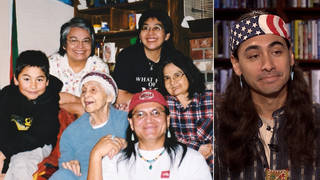
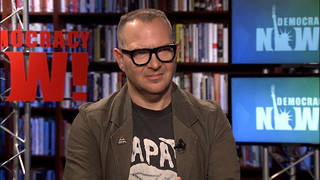
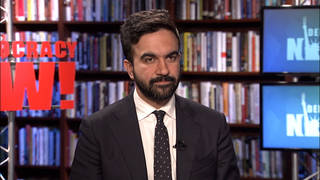
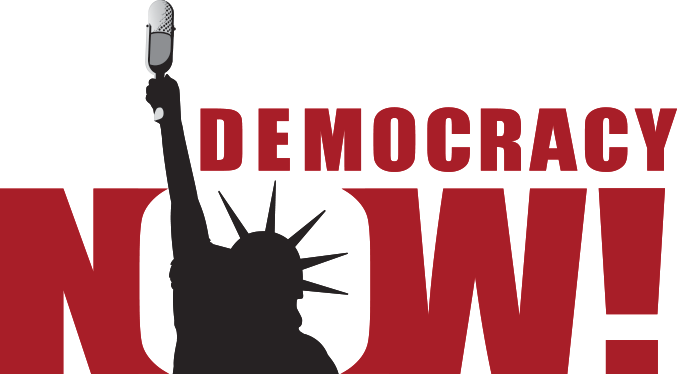
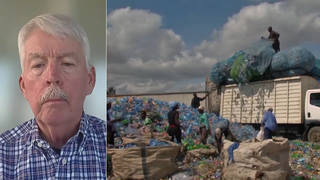
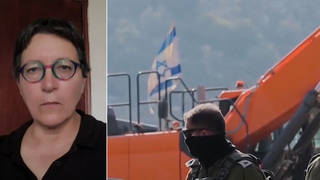
Media Options